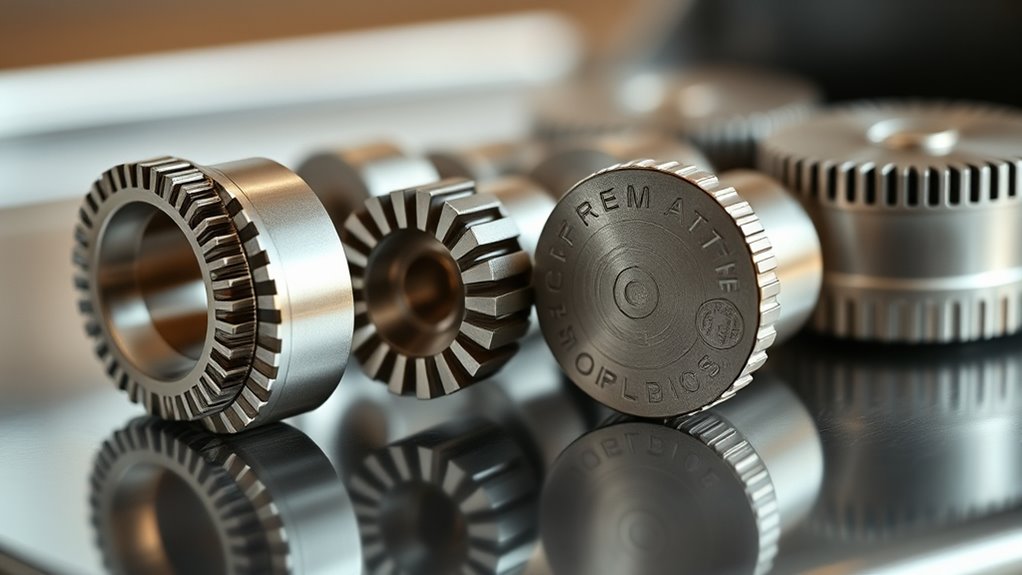To master grinder burrs, understand the main types: flat burrs, which produce consistent grounds; conical burrs, known for uniform size and lower heat; and blade burrs, faster but less precise. Consider burr material like ceramic for durability or copper coatings for heat dissipation. Check burr size for efficiency, and regularly adjust or calibrate to maintain quality. Explore further to learn how to optimize each for your brewing method.
Key Takeaways
- Understand different burr types—flat, conical, and blade—and their impact on grind consistency and maintenance needs.
- Consider burr material and coatings, such as ceramic or copper, for durability, heat dissipation, and longevity.
- Match burr size and diameter to your brewing method for optimal grind quality and efficiency.
- Learn proper adjustment and calibration techniques to ensure even grinding and consistent flavor extraction.
- Implement regular cleaning and alignment checks to prolong grinder lifespan and maintain optimal performance.
Flat Burrs
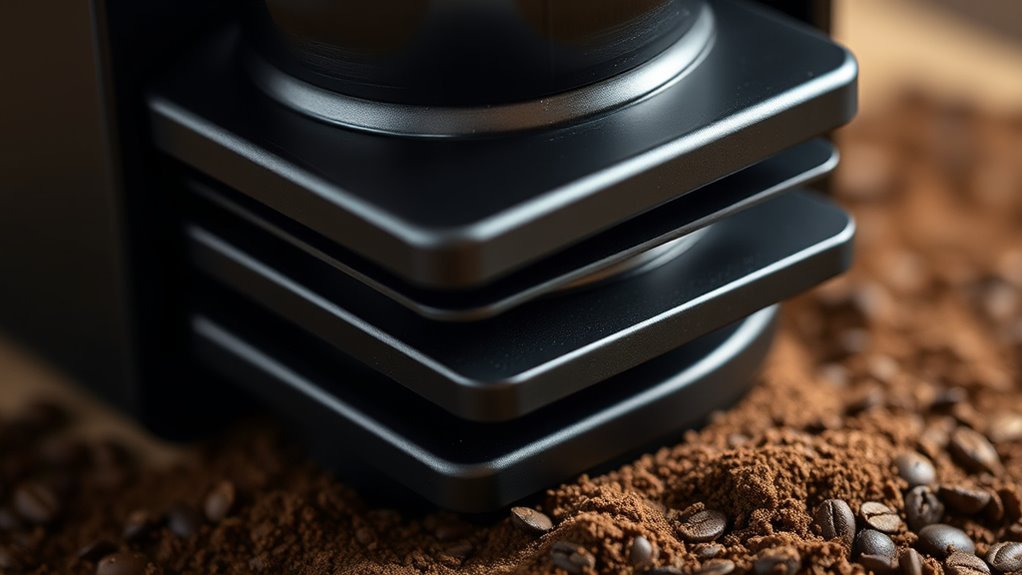
Have you ever wondered why many coffee enthusiasts prefer flat burrs? It’s mainly because they produce a consistent grind size, essential for brewing quality coffee. To keep your flat burr grinder performing at its best, regular grinder maintenance is key. This includes cleaning out residual coffee grounds and checking the burr alignment frequently. Proper burr alignment ensures even grinding and prevents uneven extraction, which can alter flavor. Misaligned burrs can cause uneven wear, reducing the grinder’s efficiency and lifespan. When maintaining your grinder, pay close attention to the burrs’ positioning and ensure they are perfectly aligned. This simple step can drastically improve grind consistency and save you from costly repairs or replacements later. Flat burrs, paired with diligent maintenance, deliver excellent coffee results, as maintaining burr alignment is crucial for optimal performance.
Conical Burrs
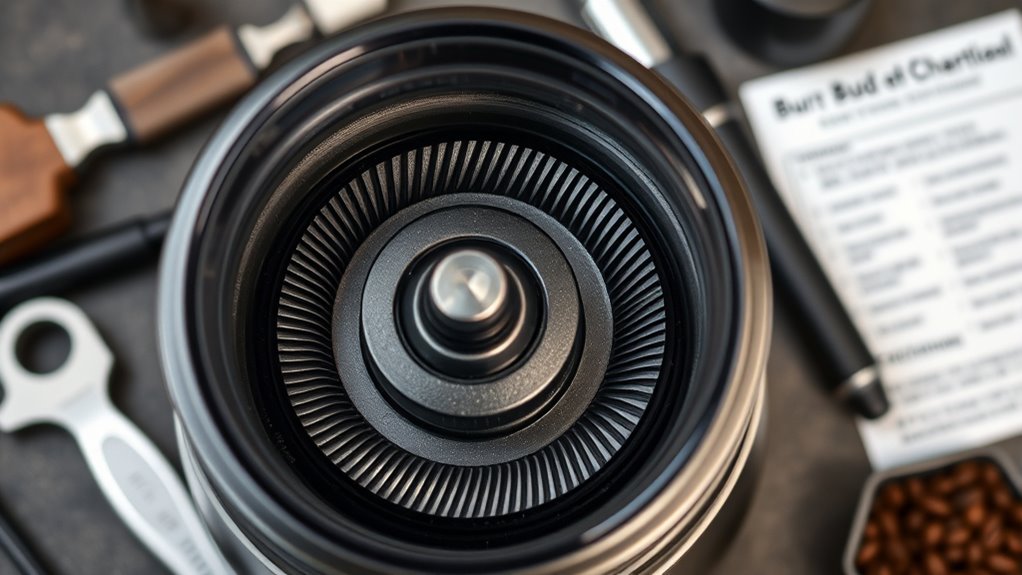
Conical burrs are popular among coffee enthusiasts because they create a uniform grind while generating less heat during grinding. This results in better flavor preservation and consistent extraction. Their design minimizes the noise level, making them a quieter option for home use. Regular grinder calibration is essential to maintain grind consistency and prevent uneven extraction. Conical burrs handle different grind sizes effectively, from espresso to French press. They are durable and tend to clog less, which reduces maintenance. Additionally, studies indicate that conical burrs can lead to a more consistent grind and better overall brewing results. Here’s a quick comparison:
| Feature | Benefits |
|---|---|
| Grinder calibration | Ensures uniform grind and flavor |
| Noise level | Quieter operation, less disturbance |
| Durability | Long-lasting, minimal clogging |
| Versatility | Suitable for various brewing methods |
Blade Burrs
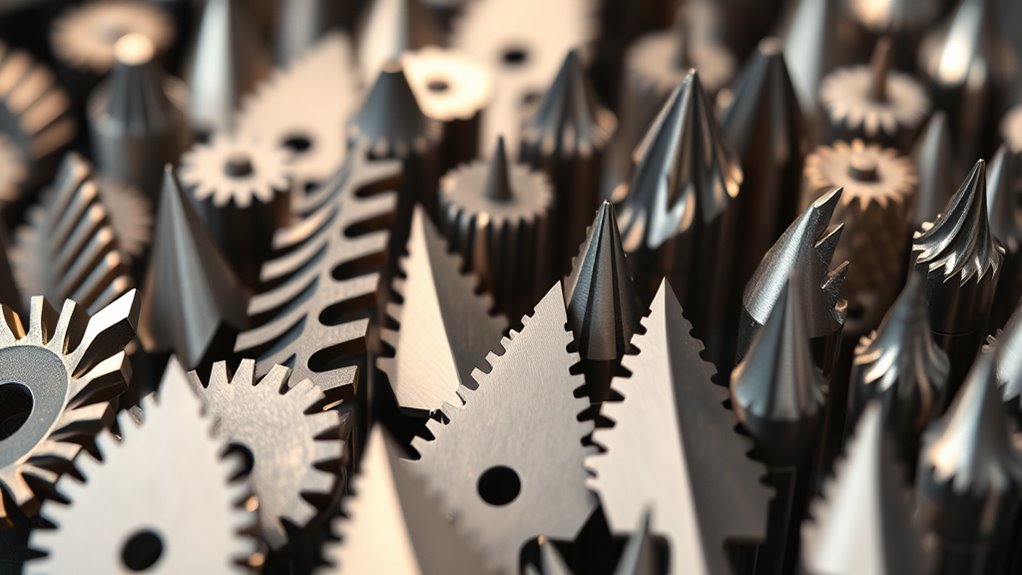
Blade burrs are a different approach to grinding coffee beans, relying on sharp, spinning blades rather than precision burrs. This method produces a more inconsistent grind size, which can affect flavor extraction. One noticeable aspect of blade grinders is the increased grinder noise during operation, making them louder than burr grinders. Cleaning maintenance is essential with blade burrs because leftover coffee grounds can clog the blades and reduce performance. Regularly disassemble and clean the blades to prevent buildup, ensuring consistent grinding and prolonging the grinder’s lifespan. While blade burrs are often more affordable and faster, they require more frequent cleaning and can lead to uneven grounds, impacting brew quality. Consider these factors when choosing a grinder type for your brewing needs. Additionally, understanding different burr types can help you select the best grinder for your specific requirements.
Burr Material and Coatings
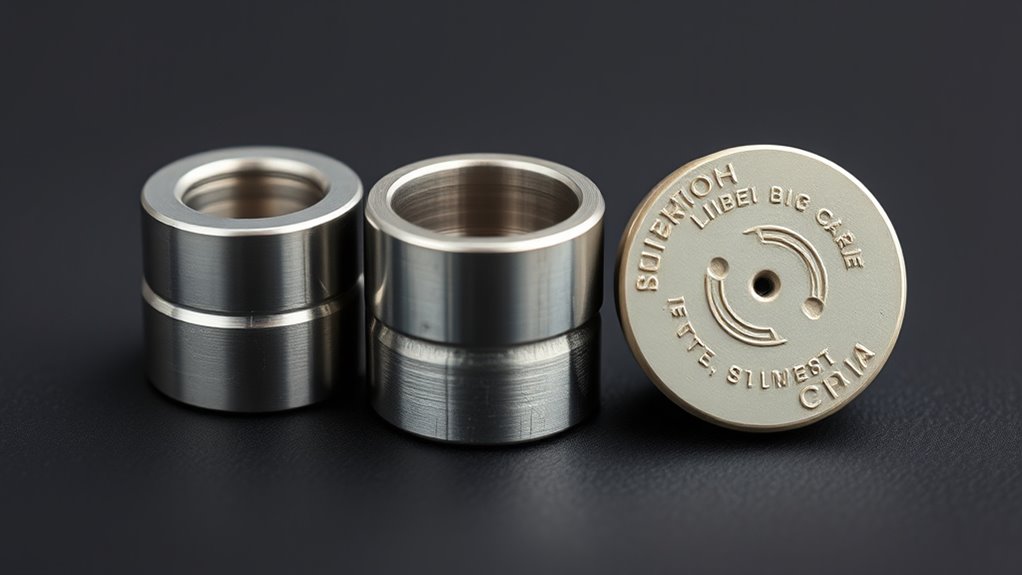
The choice of burr material and coatings plays a crucial role in the durability and performance of your grinder. Copper coatings, while less common, can provide some corrosion resistance and improve heat dissipation, but they may wear faster over time. Ceramic burrs are known for their hardness and ability to stay sharp longer, offering consistent grinding performance and reduced heat transfer. They’re also resistant to rust and corrosion, making them ideal for long-term use. However, ceramic burrs tend to be brittle and can chip if mishandled or subjected to hard objects. When selecting burr material and coatings, consider your grinding needs, maintenance preferences, and budget. Proper choice ensures your grinder operates efficiently and produces quality grounds over time. Material properties also influence how well the burrs withstand the stresses of regular use and the quality of the grind produced.
Burr Size and Diameter
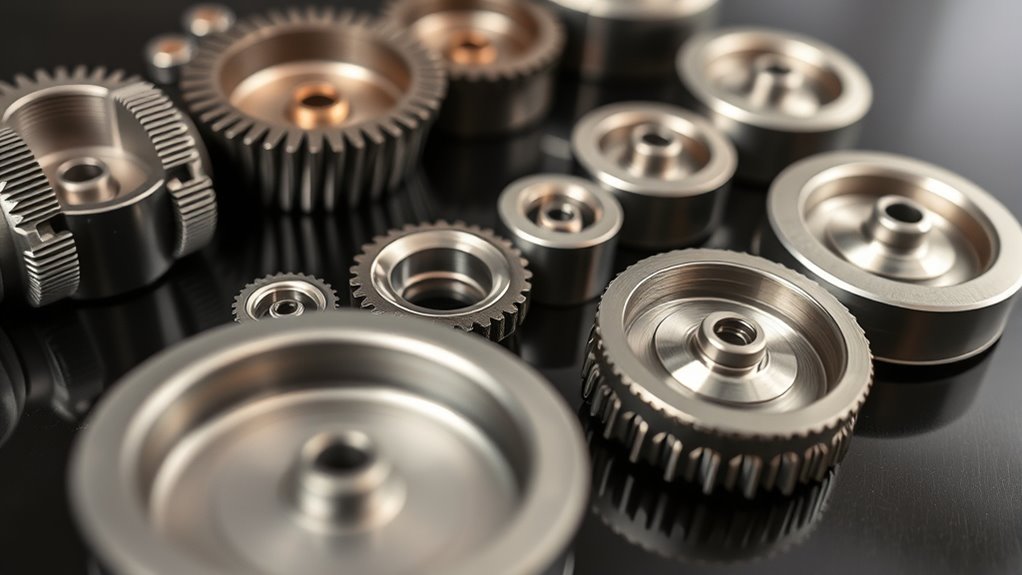
Burr size and diameter can impact your grind consistency and extraction. You’ll find options that range from standard sizes to larger diameters, each with its advantages. Understanding these differences helps you choose the right burr for your brewing needs. Larger burrs generally provide a more consistent grind and are preferred for precision tuning, especially in commercial or high-volume settings.
Burr Size Variability
Burr size and diameter can considerably impact your coffee grinding performance. Variability in burr size influences not just grind consistency but also grinder noise levels and energy consumption. Larger burrs typically produce more uniform grounds, which enhances flavor extraction. They also tend to operate more efficiently, reducing energy use. Conversely, smaller burrs may require more effort, increasing noise during operation and consuming more power. The size difference affects how quickly you can grind beans, with bigger burrs often grinding faster due to increased surface area. Additionally, burr technology plays a significant role in overall grinding quality, further influencing your brewing experience. Understanding burr size variability helps you select a grinder that balances performance with noise and energy efficiency, ensuring you get the best results for your brewing needs.
Standard vs. Large
Choosing between standard and large burrs substantially impacts your coffee grinder’s performance. Larger burrs generally require more grinder motor power, leading to higher efficiency and consistency. They produce a coarser, more uniform grind, ideal for brewing methods like French press or cold brew. Standard burrs are smaller, consuming less power, and tend to be quieter but may struggle with larger quantities. Here’s a quick comparison:
| Feature | Standard Burrs | Large Burrs |
|---|---|---|
| Grinder motor power | Lower | Higher |
| Noise level | Quieter | Slightly louder |
| Grind size | Finer, less uniform | Coarser, more consistent |
| Quantity capacity | Smaller batches | Larger batches |
Consider your brewing needs and noise preferences to choose the right size. Additionally, personality traits such as patience and consistency can influence your choice for optimal results.
Burr Adjustment and Grind Consistency
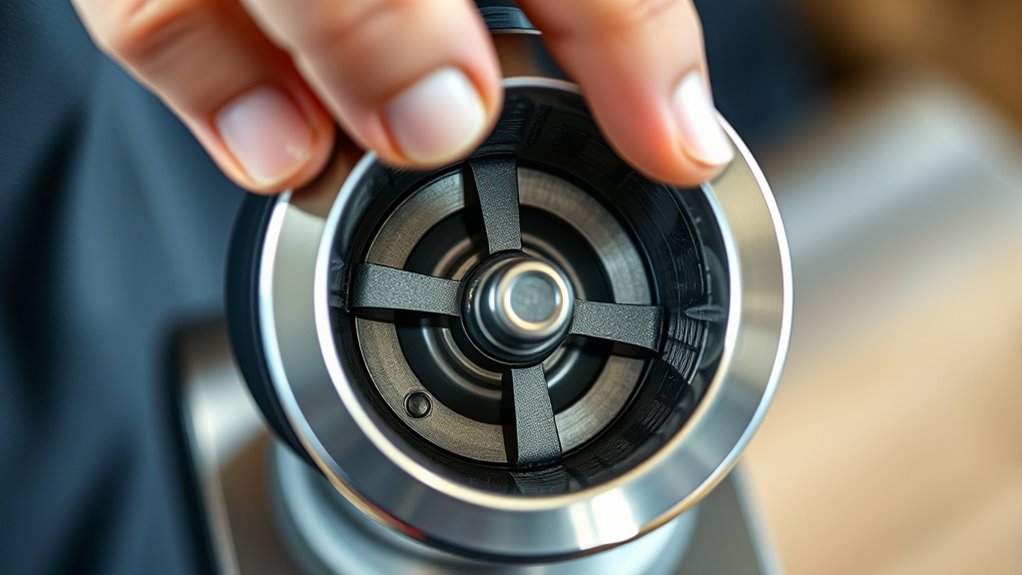
Adjusting your burrs correctly is key to achieving a consistent grind. You can modify the settings manually or use built-in mechanisms to fine-tune the grind size. Regularly maintaining uniform grind guarantees your coffee brews taste balanced and flavorful. Incorporating mindfulness practices during grinding can help you stay attentive to the consistency and quality of your coffee.
Burr Adjustment Methods
To maintain consistent grind size, understanding how to properly adjust your grinder’s burrs is vital. Burr adjustment methods directly impact grind uniformity and adjustment precision, which are essential for brewing quality coffee. Most grinders feature a step or dial adjustment, allowing you to fine-tune the distance between burrs. For consistent results, start with manufacturer guidelines and make small, incremental adjustments. Some grinders have a grind setting scale, while others require trial and error. Always adjust with the grinder off to prevent damage. After adjustments, run a small amount of coffee through to test consistency. Regular calibration ensures your grind remains uniform, helping you achieve optimal extraction and flavor. Proper burr adjustment is the foundation of precise, uniform coffee grounds. Understanding fan culture can also help industry professionals anticipate preferences and trends among coffee enthusiasts.
Maintaining Uniform Grind
Maintaining a uniform grind is essential for brewing consistent, high-quality coffee, and it starts with proper burr adjustment. Regular grinder maintenance helps ensure your grind stays even, preventing issues like over-extraction or clogging. To troubleshoot grind issues, check your burr alignment and adjust as needed. Keep in mind that inconsistent grinds often stem from misaligned burrs or worn parts. Here’s a quick visual:
| Burr Type | Adjustment Method | Common Troubleshooting Tips |
|---|---|---|
| Flat Burrs | Turn grinder dial | Clean burrs regularly |
| Conical Burrs | Use calibration tool | Check for burr wear |
| Blade Burrs | Replace or sharpen | Avoid grinding too coarse |
Staying on top of grinder maintenance will help you maintain grind consistency and troubleshoot issues efficiently. Proper burr alignment is crucial for ensuring your grinder functions optimally.
Compatibility With Brewing Methods
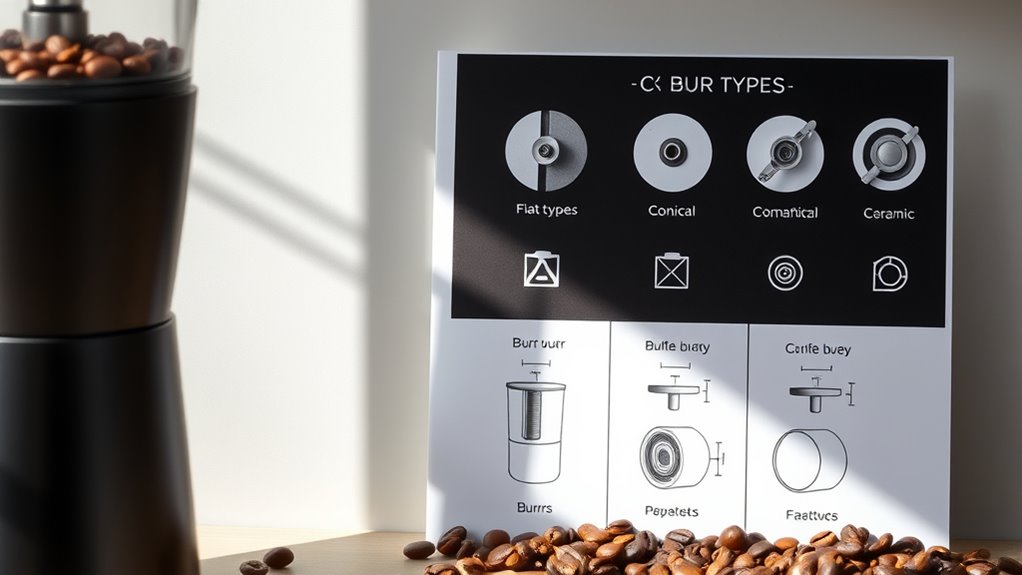
The compatibility of grinder burr types with different brewing methods considerably impacts your coffee experience. For pour-over or AeroPress, you’ll want a burr type that produces a consistent, medium grind, guaranteeing ideal extraction. Espresso demands a fine, uniform grind; conical burrs often excel here, reducing grinder noise and making precise adjustments easier. French press and cold brew benefit from coarser settings, which can be achieved with flat burrs that handle larger particles well. Additionally, consider how cleaning procedures differ; burrs that are easy to clean help prevent flavor contamination and maintain grind consistency. Selecting the right burr type ensures your grinder adapts smoothly to your preferred brewing method, enhancing flavor clarity and overall coffee enjoyment. Furthermore, grind size consistency plays a crucial role in achieving optimal extraction and flavor profile across various brewing methods.
Frequently Asked Questions
Which Burr Type Produces the Most Uniform Grind?
You’ll find that conical burrs produce the most uniform grind because of their design, which guarantees consistent particle size and reduces heat buildup. When comparing uniformity, conical burr material types like ceramic or stainless steel also matter; ceramic tends to stay sharper longer, offering better consistency. Overall, for the most uniform grind, choose conical burrs made from high-quality materials, as they excel in uniformity comparison and durability.
How Do Burrs Impact the Flavor of Coffee?
Burrs can make or break your coffee’s flavor, so don’t underestimate their power. You get what you grind for, and the burr material—whether ceramic or steel—affects grind consistency, which in turn influences flavor extraction. A smooth, uniform grind ensures even brewing, highlighting nuanced notes. On the flip side, inconsistent grinds can cause bitter or sour flavors. Choosing the right burrs is essential for revealing the full potential of your coffee beans.
Are Expensive Burrs Worth the Investment?
Yes, expensive burrs are often worth the investment. They typically feature higher-quality burr material like ceramic or hardened steel, which improves durability and consistency. While the initial cost is higher, they last longer and maintain sharpness better, reducing the need for frequent replacements. Over time, this balance of cost vs durability conserves you money and ensures a consistently great grind, enhancing your coffee experience.
How Often Should I Replace My Grinder Burrs?
You should replace your grinder burrs every 1,000 to 2,000 pounds of coffee or about annually, depending on your burr material and maintenance schedule. Regularly inspect for dullness or uneven grind, especially if you notice inconsistent extraction. Maintaining a consistent cleaning routine and using high-quality coffee beans can extend their lifespan. Ultimately, replacing them when you notice a decline in grind quality guarantees superior flavor and machine performance.
Can Different Burrs Be Used Interchangeably?
You can’t just swap burrs like they’re puzzles; using different burr material or size without checking compatibility could ruin your coffee game. Burrs are designed specifically for your grinder, and mismatched burr size or material may cause uneven grinding or damage. Always verify that the burr material and size match your grinder’s specifications. Think of it as fitting a key—if it doesn’t fit perfectly, your coffee’s going to suffer.
Conclusion
Choosing the right grinder burrs can subtly elevate your brewing experience, making each cup a little more special. By paying attention to burr type, material, size, and compatibility, you gently steer toward better flavor and consistency. Remember, the right burrs aren’t just a detail—they’re the quiet foundation of a great brew. A thoughtful selection might not change everything overnight, but it certainly guides you toward a more satisfying coffee journey.
